|
|
|
Sort Order |
|
|
|
Items / Page
|
|
|
|
|
|
|
| Srl | Item |
| 1 |
ID:
153713
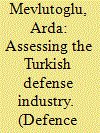

|
|
|
|
|
| Summary/Abstract |
The reform process of Turkish defense industry as launched in the last quarter of the twentieth century has seen several achievements, as well as downfalls, and passed through major milestones. The resultant industrial structure is unique, compared to the other sectors in the country. Dominated by the TSKGV (Turkish Armed Forces Foundation), the major goal of the sector has always been involved in attaining self-sufficiency, indicative of an import substitution-oriented industry policy. This strategy is evident in decision-making and execution processes of virtually all defense procurement programs. However, lack of an efficient mechanism for science and technology policy-making mechanism, is observed as a major obstacle toward sustainable development of the sector. Although benefited from the overall economic take-off during the 2000s, today the Turkish defense industry faces to the challenge of sustainability, which is heavily dependent on export performance. The forthcoming period will test the sector, revealing the necessary coordination and communication by and between the military and civilian bureaucracies.
|
|
|
|
|
|
|
|
|
|
|
|
|
|
|
|
| 2 |
ID:
140553
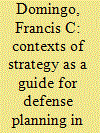

|
|
|
|
|
| Summary/Abstract |
Efforts toward developing an independent and credible Philippine defense policy were revived when Benigno Simeon C. Aquino III was elected President of the Philippines in 2010. President Aquino renewed the military modernization program in 2012 and emphasized the necessity of a “minimum credible defense posture.” Given the modernization efforts of the government, this article aims to contribute to the development of the concept of minimum credible defense posture by exploring how theory contributes to defense planning. It argues that the contexts of strategy are useful in planning for national defense because these contexts can provide a conceptual framework for defense planners. It proceeds in three parts: the opening section reviews the literature on defense planning; the second surveys the context of developing strategies as discussed in the General Theory of Strategy; and the last provides a definition of minimum credible defense and applies the context of developing strategies to the case of the Philippines.
|
|
|
|
|
|
|
|
|
|
|
|
|
|
|
|
| 3 |
ID:
171712


|
|
|
|
|
| Summary/Abstract |
Resource allocation to and within defense budgets is grand strategy. NATO and the EU coordinate defense planning and encourage fair burden-sharing among their members. We analyze the effect of agreed planning processes, namely the “NATO Defense Planning Process (NDPP)” on the conversion of political will to resources and then to capabilities development across the transatlantic security community. In a “fog of peace” featuring diverse threats, and in which allies may disagree on strategic rivals and sources of risk, national and regional political economies shape strategy, not the other way around.
|
|
|
|
|
|
|
|
|
|
|
|
|
|
|
|
| 4 |
ID:
161360
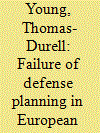

|
|
|
|
|
| Summary/Abstract |
By any objective measure, defense institutions in Central and Eastern Europe have all but universally been incapable of producing viable defense plans that are based on objective costing and operational planning data. This situation exists in spite the provision of considerable Western advice and assistance, let alone reporting to and receiving assessments by NATO’s International Staff under Partnership for Peace, as well as via the integrated defense planning and reporting systems. An explanation for this systematic failure across European post-Communist defense institutions can be found in the continued slow development of an over-arching policy framework which directs and approves all activities of the armed forces, as well as the de-centralization of financial decision-making down to capability providers. The essay ends with an examination of the adverse effects of the early introduction of planning programming, budgeting system (PPBS), have had on the development of effective policy and planning capabilities within these defense institutions.
|
|
|
|
|
|
|
|
|
|
|
|
|
|
|
|
| 5 |
ID:
143284


|
|
|
|
|
| Summary/Abstract |
The growing trend toward the securitization of infectious disease has legitimated a role for national militaries in responding to public health crises. This apparent “militarization” of health has met with resistance from the health and security sectors alike, who argue that it risks politicizing health outcomes while also draining limited military resources. This article attempts to place such concerns within the broader historical context of military involvement in public health. With specific reference to pandemic influenza—a disease of great historical import and a current policy priority in the context of securitized global public health—this article details the pedigree of military involvement in fighting the disease and draws on the established record to demonstrate the role that militaries can play in improving public health outcomes. The article argues for an ongoing military role in the global fight against pandemic influenza, both in augmenting civil influenza programs and in improving their own preparation and response mechanisms for future pandemics.
|
|
|
|
|
|
|
|
|
|
|
|
|
|
|
|
| 6 |
ID:
121965
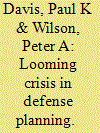

|
|
|
| 7 |
ID:
148352


|
|
|
|
|
| Summary/Abstract |
Hungary, a former communist state, adapted a Western-style defense planning system during the 1990s and 2000s. Although on the surface the elements of this planning system were similar to the planning programming budgeting system (PPBS) developed by the US Department of Defense, strategic guidance for defense planning has not been properly developed until recently. Thus, albeit PPBS-based defense plans were developed in the Hungarian Ministry of Defense (Hungarian MoD) regularly, they lacked both an expression of clear priorities and strategic focus. This article delineates the evolution of strategic guidance in the Hungarian MoD concentrating on current developments, and introduces the newly elaborated analytical concepts and tools, which helped to create needed strategic guidance in Hungary.
|
|
|
|
|
|
|
|
|
|
|
|
|
|
|
|
| 8 |
ID:
130023
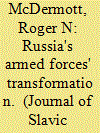

|
|
|
|
|
| Publication |
2014.
|
| Summary/Abstract |
Since the creation of the Armed Forces of the Russian Federation in 1992, the Kremlin has grappled, struggled or even procrastinated on addressing the question of what type of force structure may best suit the state's security environment. A number of initiatives frequently represented as 'reform' have come and gone, falling by the wayside due to internal inertia, institutional resistance to root and branch reform or, indeed, as a result of the political-military elite failing to come to terms with the disintegration of the Soviet Union. Transitioning from the Soviet legacy force to something more akin to the forces needed to protect the Russian state and adapt to the modern warfare environment to meet a number of differing challenges ranging from counterinsurgency to peacekeeping or dealing with an unforeseen military crisis plagued Moscow's defense planning.
|
|
|
|
|
|
|
|
|
|
|
|
|
|
|
|
| 9 |
ID:
140623


|
|
|
|
|
| Publication |
New York, American Elsevier publishing Company, Inc., 1968.
|
| Description |
xxiii, 453p.: figures, tableshbk
|
|
|
|
|
|
|
|
|
|
|
|
Copies: C:1/I:0,R:0,Q:0
Circulation
| Accession# | Call# | Current Location | Status | Policy | Location |
| 002977 | 658.4032/QUA 002977 | Main | On Shelf | General | |
|
|
|
|
| 10 |
ID:
163629


|
|
|
| 11 |
ID:
137937


|
|
|
|
|
| Summary/Abstract |
This article investigates how US national security planners have envisioned the emerging strategic environment during the early twenty-first century and evaluates how their perceptions of this strategic environment have changed during these years. This conceptual evolution can be seen in how defense planners define threats, identify defense priorities, and design security strategies. Five key strategic planning documents serve as the basis for this analysis and illustrate significant shifts in how the US government has envisioned its own security requirements as well as the context within which its strategic vision will need to be realized. These planning documents are: (1) Joint Vision 2020, (2) the Bush Administration’s 2002 National Security Strategy of the United States, (3) the Obama Administration’s 2010 National Security Strategy, (4) US Strategic Defense Guidance entitled Sustaining US Global Leadership: Priorities for 21st Century Defense, and (5) the US Chairman of the Joint Chiefs of Staff’s Capstone Concept for Joint Operations: Joint Force 2020.
|
|
|
|
|
|
|
|
|
|
|
|
|
|
|
|
| 12 |
ID:
149014
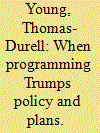

|
|
|
|
|
| Summary/Abstract |
Traditionally, policy and planning have been institutionally weak in the Naval Staff (Office of the Chief of Naval Operations – OPNAV). In their place, the N8 (Programming) has dominated resource decision-making, and, by default, decisions relating to policy and planning. Recent uncertainty over defense authorization and appropriations has resulted in calls for a greater role to be played by the N3/5, Policy and Plans Directorate. The article argues that reform of the Department of the Navy’s planning process is urgently needed. OPNAV’s weak planning and overly dominant programming practices are compared with those of the Departments of the Army and Air Force and are shown to be out of conformance with them. The article concludes with specific and detailed recommendations for reform of both the current planning and programming processes.
|
|
|
|
|
|
|
|
|
|
|
|
|
|
|
|
|
|
|
|
|